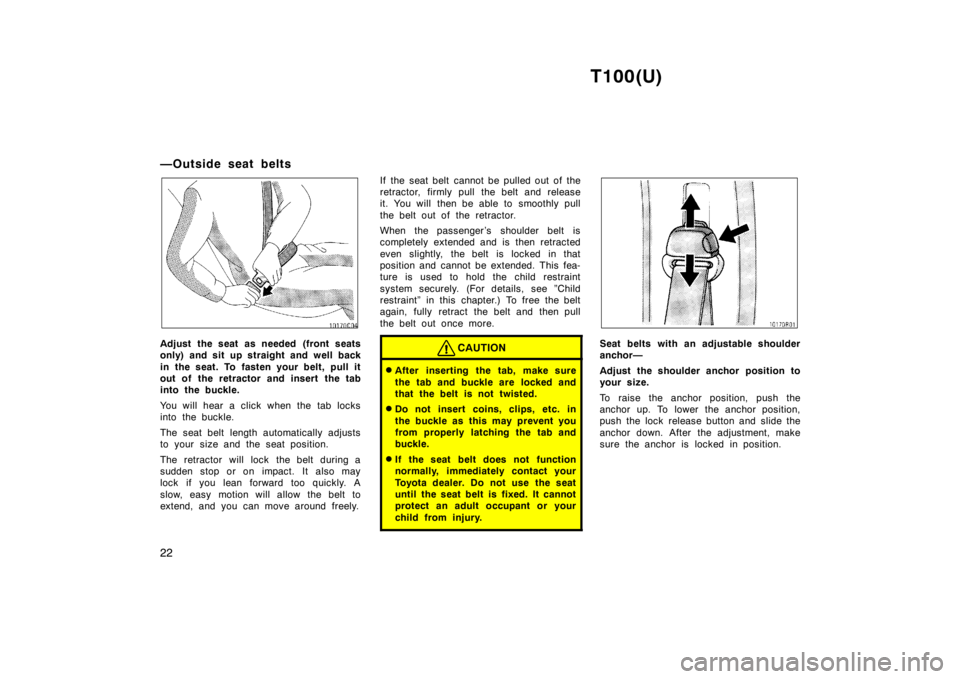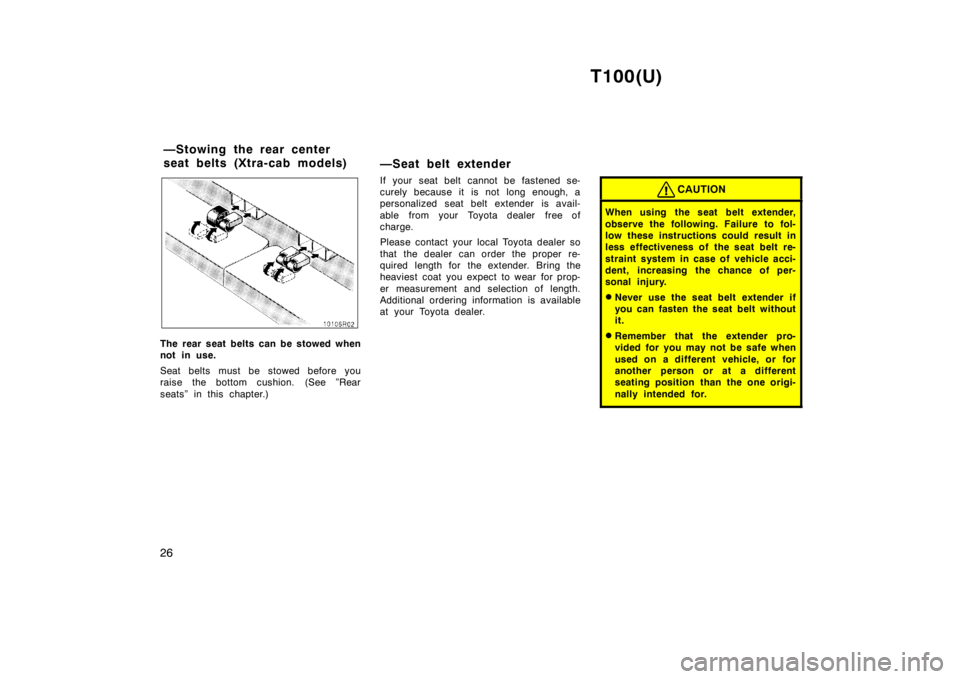Page 22 of 214

T100(U)
22
—Outside seat belts
Adjust the seat as needed (front seats
only) and sit up straight and well back
in the seat. To fasten your belt, pull it
out of the retractor and insert the tab
into the buckle.
You will hear a click when the tab locks
into the buckle.
The seat belt length automatically adjusts
to your size and the seat position.
The retractor will lock the belt during a
sudden stop or on impact. It also may
lock if you lean forward too quickly. A
slow, easy motion will allow the belt to
extend, and you can move around freely.
If the seat belt cannot be pulled out of the
retractor, firmly pull the belt and release
it. You will then be able to smoothly pull
the belt out of the retractor.
When the passenger ’s shoulder belt is
completely extended and is then retracted
even slightly, the belt is locked in that
position and cannot be extended. This fea-
ture is used to hold the child restraint
system securely. (For details, see ”Child
restraint” in this chapter.) To free the belt
again, fully retract the belt and then pull
the belt out once more.CAUTION
�
After inserting the tab, make sure
the tab and buckle are locked and
that the belt is not twisted.
� Do not insert coins, clips, etc. in
the buckle as this may prevent you
from properly latching the tab and
buckle.
� If the seat belt does not function
normally, immediately contact your
Toyota dealer. Do not use the seat
until the seat belt is fixed. It cannot
protect an adult occupant or your
child from injury.
Seat belts with an adjustable shoulder
anchor—
Adjust the shoulder anchor position to
your size.
To raise the anchor position, push the
anchor up. To lower the anchor position,
push the lock release button and slide the
anchor down. After the adjustment, make
sure the anchor is locked in position.
Page 23 of 214
T100(U)23
CAUTION
Always make sure the shoulder belt
is positioned across the center of
your shoulder. The belt should be
kept away from your neck, but not
falling off your shoulder. Failure to
do so could reduce the amount of
protection in an accident and cause
severe injuries in a co llision.
Adjust the position of the lap and
shoulder belts.
Position the lap belt as low as possible
on your hips–not on your waist, then ad-
just it to a snug fit by pulling the shoulder
portion upward through the latch plate.
CAUTION
�High-positioned lap belts and loose-
fitting belts both could cause seri-
ous injuries due to sliding under
the lap belt during a collision or
other unintended result. Keep the
lap belt positioned as low on hips
as possible.
� For your safety, do not place the
shoulder belt under your arm.
Page 24 of 214
T100(U)
24
To release the belt, press the buckle-re-
lease button and allow the belt to re-
tract.
If the belt does not retract smoothly, pull
it out and check for kinks or twists. Then
make sure it remains untwisted as it re-
tracts. —Center seat beltsSit up straight and well back in the
seat. To fasten your belt, insert the tab
into the buckle.
You will hear a click when the tab locks
into the buckle.
If the belt is not long enough for you, hold
the tab at a right angle to the belt and
pull on the tab.
CAUTION
�
After inserting the tab, make sure
the tab and buckle are locked and
that the belt is not twisted.
� Do not insert coins, clips, etc. in
the buckle as this may prevent you
from properly latching the tab and
buckle.
� If the seat belt does not function
normally, immediately contact your
Toyota dealer. Do not use the seat
until the seat belt is fixed. It cannot
protect an adult occupant or your
child from injury.
Page 25 of 214
T100(U)25
Remove excess length of the belt and
adjust the belt position.
To shorten the belt, pull the free end of
the belt.
Position the lap belt as low as possible
on your hips—not on your waist, then ad-
just it to a snug fit.
CAUTION
High−positioned and loose −fitting
belts could cause serious injuries due
to sliding under the lap belt during a
collision or other unintended result.
Keep the lap belt positioned as low
on hips as possible.
To release the belt, press the buckle-re-
lease button.The front center seat belt can be
stowed in the seat side pocket when
not in use. —Stowing the front center
seat belt (split bench seat)
Page 26 of 214

T100(U)
26
The rear seat belts can be stowed when
not in use.
Seat belts must be stowed before you
raise the bottom cushion. (See ”Rear
seats” in this chapter.) —Seat belt extender
If your seat belt cannot be fastened se-
curely because it is not long enough, a
personalized seat belt extender is avail-
able from your Toyota dealer free of
charge.
Please contact your local Toyota dealer so
that the dealer can order the proper re-
quired length for the extender. Bring the
heaviest coat you expect to wear for prop-
er measurement and selection of length.
Additional ordering information is available
at your Toyota dealer.
CAUTION
When using the seat belt extender,
observe the following. Failure to fol-
low these instructions could result in
less effectiveness of the seat belt re-
straint system in case of vehicle acci-
dent, increasing the chance of per-
sonal injury. �
Never use the seat belt extender if
you can fasten the seat belt withoutit.
� Remember that the extender pro-
vided for you may not be safe when
used on a different vehicle, or for
another person or at a different
seating position than the one origi-
nally intended for.
—Stowing the rear center
seat belts (Xtra-cab models)
Page 27 of 214

T100(U)27
To connect the extender to the seat
belt, insert the tab into the seat belt
buckle so that the ”PRESS” signs on
the buckle-release buttons of the ex-
tender and the seat belt are both facing
outward as shown.
You will hear a click when the tab locks
into the buckle.
When releasing the seat belt, press on
the buckle-release button on the extender,
not on the seat belt. This helps prevent
damage to the vehicle interior and extend-
er itself.
When not in use, remove the extender
and store in the vehicle for future use.
CAUTION
�After inserting the tab, make sure
the tab and buckle are locked and
the seat belt extender is not
twisted.
� Do not insert coins, clips, etc. in
the buckle as this may prevent you
from properly latching the tab and
buckle.
� If the seat belt does not function
normally, immediately contact your
Toyota dealer. Do not use the seat
until the seat belt is fixed. It cannot
protect an adult occupant or your
child from injury.
SRS driver airbag
The SRS (Supplemental Restraint Sys-
tem) airbag is designed to provide fur-
ther protection for the driver when add-
ed to the primary protection provided
by the seat belt.
In response to a severe frontal impact,
the SRS airbag works together with the
seat belt to help prevent or reduce injury
by inflating, in order to decrease the likeli-
hood of the driver ’s head or chest directly
hitting the steering wheel.
Be sure to wear your seat belt.
Page 28 of 214

T100(U)
28
CAUTION
A driver too close to the steering
wheel during airbag deployment can
be killed or seriously injured. Toyota
strongly recommends that: � The driver sit as far back as pos-
sible from the steering wheel while
still maintaining control of the ve-
hicle.
� All vehicle occupants be properly
restrained using the available seat
belts.
This indicator comes on when the igni-
tion key is turned to the ”ACC” or
”ON” position. It goes off after about
6 seconds. This means the SRS airbag
is operating properly.
The SRS airbag warning light system
monitors the front airbag sensors, center
airbag sensor assembly, inflator, warning
light, interconnecting wiring and power
sources.The SRS airbag system is designed to
activate in response to a severe frontal
impact within the shaded area between
the arrows in the illustration.
There may be the case that the SRS air-
bag will not activate with such an impact
in which the occupant wearing the seat
belt correctly would not get serious injury.
The SRS airbag will deploy if the severity
of the impact is above the designed
threshold level, comparable to an approxi-
mate 20 km/h (14 mph) collision when
impacting straight into a fixed barrier that
does not move or deform.
If the severity of the impact is below the
above threshold level, the SRS airbag
may not deploy.
Page 29 of 214

T100(U)29
However, this threshold velocity will be
considerably higher if the vehicle strikes
an object, such as a parked vehicle or
sign pole, which can move or deform on
impact, or if it is involved in an underride
collision (e.g. a collision in which the nose
of the vehicle ”underrides”, or goes under,
the bed of a truck).
For the safety of all occupants, be sure
to always wear seat belts.
The SRS airbag is not designed to in-
flate if the vehicle is subjected to a
side or rear impact, if it rolls over, or
if it is involved in a low-speed frontal
collision. The center airbag sensor assembly con-
sists of a safing sensor and center airbag
sensor.
In a severe frontal impact, the sensor de-
tects deceleration and the system triggers
the airbag inflator. Then a chemical reac-
tion in the inflator momentarily fills the
airbag with non-toxic gas to help restrain
the forward motion of the driver.
When the airbag inflates, it produces a
fairly loud noise and releases some
smoke along with non-toxic gas. This does
not indicate a fire. Be sure to wash off
any residue as soon as possible to pre-
vent minor skin irritation.